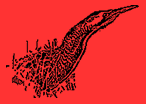Birds
Bitterns, Water Rails, Bearded Tits and indeed Otters can be seen any time and it is hard to plan. Chances with the first two are definitely improved when it freezes and late Summer evenings tend to be best for Otters. Bearded Tits tend to be most visible July to October as the young become mobile. Red Squirrels are north and south of us. Most years there are Brambling in the winter.
However, the marvellous thing about birding is that the unexpected can happen at any time and often does. It takes you to beautiful areas which this certainly is. However, if we need to, we will go further afield to take advantage of opportunities that present themselves, although there is so much to do locally. Plans will depend on the weather and the individual preferences of the participants. We need to be flexible.
What to expect - month by month
September
Return migration time. Chance of rarities. With westerly gales this is the time for Leach's Petrel. Possible Skuas. Passage Waders.
October
Still chances of rarities and Leach's Petrel still possible. Winter birding starts with the arrival of Geese and Wildfowl. With the loss of leaves Hawfinch chances improve. Large high tide flocks of Waders.
November/December
Geese. Wildfowl. Huge Wader flocks. Hawfinch and other woodland residents. Normally wintering Mediterranean Gull. Divers and Sea Duck. Good time to go for Twite and/or Corn Bunting. Could try Jack Snipe.
January/February
As November/December. Chances of vagrant Geese improve. A big freeze improves hopes for Bittern and Water Rail. Hawfinch. Still Divers and Sea Duck. Could try Water Pipit.
March
Geese still around. Hawfinch. Best time for Woodpeckers including Lesser Spotted (always difficult). Good time for Goshawk. Bitterns start booming. Goosander on the river. Also good for Water Pipit. Could go for Black Grouse and Ring Ouzel. Maybe Garganey will have arrived.
April
Still good for Woodpeckers and Goshawk. As the month progresses we seek to welcome in each of the Summer visitors. A good chance to learn or relearn to recognise by song. Marsh Harriers arrive now. The North West has a good passage of Little Gulls. Late in the month is best for Grasshopper Warbler, Lesser Whitethroat, Pied Flycatcher and Wood Warbler. We look out for passage of White Wagtails early and Whimbrel later. Late in the month, if the winds are right, there can be a good passage of Pomarine Skuas off North Cumbria. Well worth going for if we can time it right. Could fit in a visit to the Eagle site at the same time.
May
Pomarine Skuas passage still possible early. Also Dotterel (Twite at same site) go through at this time. But May is the time we wish to get all the Summer visitors before they disappear in the leaves. Later, we can try for Nightjar. There can be Quail near by. Could go for Eagle.
June
We have to work harder for the summer visitors now, but they are there! However, this can be one of the best months for evening Otter watches. Nightjar is good now. Quail again. Also Eagle. Could visit a Tern colony (including Little Tern) along with the breeding Auks and Puffins at St Bees Head.
July
Still good for Otter and Nightjar. Bearded Tits tend to be more visible from now until the Autumn. First return waders - tend to be the adults first. Still Terns and Auks. Can be a second chance for the summer visitors as the young start to move about. Storm Petrels have been seen late in the month.
August
Continuing returning Waders. Good month for rarities. Bearded Tits. Possible Hobby. Huge evening Starling roost with attacking Sparrowhawks. Water Rail quite good now.
Tel: 015395 63191 e-mail: mike@nwbirds.co.uk
